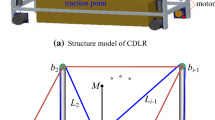Abstract
Cable-driven rehabilitation devices (CDRDs) represent a widespread class of rehabilitation robots used to restore individual impaired movement capabilities by performing repetitive rehabilitation training of impaired extremities. CDRDs offer several merits, such as low inertia, high payload-to-weight ratio, modularity, simple architecture, and convenient for reconfiguration. In this paper, a model that takes into account the particular features (pulleys and magnetic hook) of the cables of a CDRD is presented. Experimental tests carried out with the modal analysis approach show that the model is able to reproduce most of the dynamic properties of the vibrating system equipped with cables.
Access this chapter
Tax calculation will be finalised at checkout
Purchases are for personal use only
Similar content being viewed by others
References
Wang, Y., Yu, F., Li, Q., Chen, Y.: Configuration selection and vibration analysis of double layer suspended cable-driven parallel robot for intelligent storage system. In: Liu, X.-J., Nie, Z., Yu, J., Xie, F., Song, R. (eds.) ICIRA 2021. LNCS (LNAI), vol. 13013, pp. 564–574. Springer, Cham (2021). https://doi.org/10.1007/978-3-030-89095-7_54
Chesher, C.: Robots and the moving camera in cinema, television and digital media. In: Koh, J.T.K.V., Dunstan, B.J., Silvera-Tawil, D., Velonaki, M. (eds.) CR 2015. LNCS (LNAI), vol. 9549, pp. 98–106. Springer, Cham (2016). https://doi.org/10.1007/978-3-319-42945-8_9
Mao, Y., Agrawal, S.K.: Design of a cable-driven arm exoskeleton (CAREX) for neural rehabilitation. IEEE Trans. Rob. 28(4), 922–931 (2012). https://doi.org/10.1109/TRO.2012.2189496
Cafolla, D., Russo, M., Carbone, G.: Cube, a cable-driven device for limb rehabilitation. J. Bionic Eng. 16(3), 492–502 (2019). https://doi.org/10.1007/s42235-019-0040-5
Fanin, C., Gallina, P., Rossi, A., Zanatta, U., Masiero, S.: Nerebot: a wire-based robot for neurorehabilitation. In: ICORR 2003, HWRS-ERC, pp. 23–27 (2003)
Laribi, M.A., Ceccarelli, M., Sandoval, J., Bottin, M., Rosati, G.: Experimental validation of light cable-driven elbow-assisting device l-cadel design. J. Bionic Eng. 19, 416–428 (2022). https://doi.org/10.1007/s42235-021-00133-5
Zuccon, G., Bottin, M., Ceccarelli, M., Rosati, G.: Design and performance of an elbow assisting mechanism. Mach. 8(4), 68 (2020). https://doi.org/10.3390/machines8040068
Boschetti, G., Minto, R., Trevisani, A.: Experimental investigation of a cable robot recovery strategy. Robotics 10(1), 1–18 (2021). https://doi.org/10.3390/robotics10010035
Du, J., Agrawal, S.K.: Dynamic modeling of cable-driven parallel manipulators with distributed mass flexible cables. J. Vib. Acous. 137(2), 021020 (2015). https://doi.org/10.1115/1.4029486
Mayhew, D., Bachrach, B., Rymer, W.Z., Beer, R.F.: Development of the macarm-a novel cable robot for upper limb neurorehabilitation. In: 9th International Conference on Rehabilitation Robotics, ICORR 2005, pp. 299–302. IEEE (2005). https://doi.org/10.1109/ICORR.2005.1501106
Proietti, T., Crocher, V., Roby-Brami, A., Jarrasse, N.: Upper-limb robotic exoskeletons for neurorehabilitation: a review on control strategies. IEEE Rev. Biomed. Eng. 9, 4–14 (2016). https://doi.org/10.1109/RBME.2016.2552201
Diao, X., Ma, O.: Vibration analysis of cable-driven parallel manipulators. Multibody Sys. Dyn. 21(4), 347–360 (2009). https://doi.org/10.1007/s11044-008-9144-0
Behzadipour, S., Khajepour, A.: Stiffness of cable-based parallel manipulators with application to stability analysis (2006). https://doi.org/10.1115/1.2114890
Verhoeven, R., Hiller, M., Tadokoro, S.: Workspace, stiffness, singularities and classification of tendon-driven stewart platforms. In: Advances in Robot Kinematics: Analysis and Control, pp. 105–114. Springer (1998). https://doi.org/10.1007/978-94-015-9064-8_11
Kawamura, S., Kino, H., Won, C.: High-speed manipulation by using parallel wire-driven robots. Robotica 18(1), 13–21 (2000). https://doi.org/10.1017/S0263574799002477
Khosravi, M.A., Taghirad, H.D.: Dynamic analysis and control of cable driven robots with elastic cables. Trans. Can. Soc. Mech. Eng. 35(4), 543–557 (2011). https://doi.org/10.1139/tcsme-2011-0033
Tho, T.P., Thinh, N.T.: Analysis and evaluation of CDPR cable sagging based on ANFIS. Math. Probl. Eng. 2021, 20 (2021). https://doi.org/10.1155/2021/4776317
Rosati, G., Andreolli, M., Biondi, A., Gallina, P.: Performance of cable suspended robots for upper limb rehabilitation. In: 2007 IEEE 10th International Conference on Rehabilitation Robotics, pp. 385–392. IEEE (2007). https://doi.org/10.1109/ICORR.2007.4428454
Rosati, G., Gallina, P., Masiero, S., Rossi, A.: Design of a new 5 dof wire-based robot for rehabilitation. In: 9th International Conference on Rehabilitation Robotics, ICORR 2005, pp. 430–433. IEEE (2005). https://doi.org/10.1109/ICORR.2005.1501135
Doria, A., Cocuzza, S., Comand, N., Bottin, M., Rossi, A.: Analysis of the compliance properties of an industrial robot with the Mozzi axis approach. Robotics 8(3), 80 (2019). https://doi.org/10.3390/robotics8030080
Author information
Authors and Affiliations
Corresponding author
Editor information
Editors and Affiliations
Rights and permissions
Copyright information
© 2022 The Author(s), under exclusive license to Springer Nature Switzerland AG
About this paper
Cite this paper
Zuccon, G., Tang, L., Doria, A., Bottin, M., Minto, R., Rosati, G. (2022). The Effect of Pulleys and Hooks on the Vibrations of Cable Rehabilitation Robots. In: Niola, V., Gasparetto, A., Quaglia, G., Carbone, G. (eds) Advances in Italian Mechanism Science. IFToMM Italy 2022. Mechanisms and Machine Science, vol 122. Springer, Cham. https://doi.org/10.1007/978-3-031-10776-4_32
Download citation
DOI: https://doi.org/10.1007/978-3-031-10776-4_32
Published:
Publisher Name: Springer, Cham
Print ISBN: 978-3-031-10775-7
Online ISBN: 978-3-031-10776-4
eBook Packages: Intelligent Technologies and RoboticsIntelligent Technologies and Robotics (R0)




